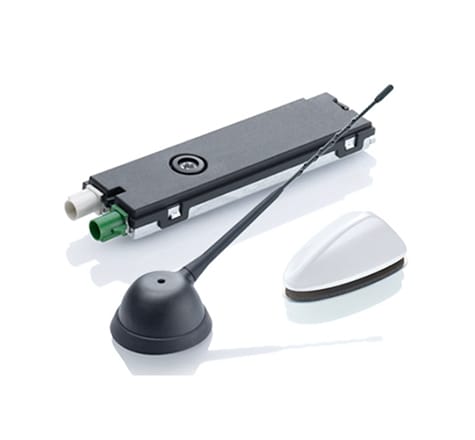
Tech Explainer: 5G Ecosystem
Trend Insight
The New Edge of Computing
5G is expected to deliver the performance needed to enable Enhanced Mobile Broadband, Massive IoT, and Mission Critical Communications (MCC). To make this possible, you need to understand the design requirements and the best-fit solutions.
Industry 4.0, 5G IIoT, IoT, AI, AR, the cloud, the fog, the edge, MCC, nodes, and gateways. Everything is supposed to be getting simpler, but the number of terms and abbreviations keeps on growing. The dream is a fail-safe automated production plant that can be quickly and flexibly adapted to individual needs.
The new mobile network standard 5G is ready to get started in Germany. It will be one of the important milestones for the realization of improved automation concepts like this, which are presently covered by terms such as Industry 4.0 and IIoT.
A hundred times faster than LTE, the new 5G standard can transmit data wirelessly at speeds up to 20 Gbit/s with a latency of less than 10 ms. Other properties were also required for 5G, such as high reliability, high availability, energy efficiency, and high device density combined with good accessibility.
However, 5G was not developed exclusively for industrial applications. It basically targets three areas: Enhanced Mobile Broadband, Massive IoT, and Mission Critical Communications (MCC). The latter covers the subject we want to deal with in more detail here. The essential criteria for MCC are high reliability, very low latency, and very good availability.
Edge devices – smartphones, smart watches, VR headsets, and connected cars – can enable an ecosystem of 5G Edge Computing that provides greater capacity, lower latency, more mobility, and increased reliability and availability.
What can 5G mean for production operations in the MCC environment, and which products can support this on the hardware side? Let's first consider an example, namely a person who wants to use various sensors to monitor and control the health of their body's ecosystem. Most of us already know about this from our own experience – we use our personal edge computer or server, otherwise known as a smartphone, to collect and evaluate data where it occurs. Among other things, it counts our steps, measures our heat rate and determines our location and elevation, and it processes this data almost immediately to give us usable results.
Of course, these parameters could also be evaluated before the advent of smartphones, but then you first had to collect the data and manually enter it in a computer, and then use a program to evaluate everything. Smartphones have enabled us to respond to conditions such as critical health parameters in real time. Since the programs usually run directly on the smartphone and the data does not have to be uploaded to a program installed on a (cloud) server, the smartphone in this example is in fact a sort of edge computer, since it collects and evaluates a lot of data directly on site – an aspect that supports one of the requirements of 5G MCC, namely lower latency times.
The situation is exactly the same when we want to use 5G technology to boost production processes to a higher level in the framework of Industry 4.0. A large number of sensors can be wirelessly networked to an edge computer, independent of the existing cable infrastructure, and can monitor a process in virtually real time and trigger appropriate corrective actions.
Good accessibility of all this is ensured by Massive MiMo antenna technology in the surrounding area, along with reliable and fast connectors in the hardware of the edge server or computer. The performance capability of the antennas linked to the sensors is also very important, because low latency is of little use if, for example, a forklift truck is accidentally parked near an antenna and unintentionally interferes with reception and transmission.
Now let's revisit the smartphone example. Technologies have made it possible to achieve real-time control in this situation. One of these is improved processor performance – first generation devices would be totally overwhelmed by the biometric data acquisition tasks that are now common – but parameters such as speed and accuracy of data access, for example location data (GPS, GNSS, etc.), have been improved by corresponding wireless and antenna technology.
Our test laboratories with suitable simulations allow us to develop antennas that enable devices to be energy-efficient, readily accessible, and work well even with high transmission density. Here we can draw on the full spectrum of current antenna technologies, including chip antennas, flexible antennas and complex 3D MID antenna structures, and in the area of Massive MiMo antennas we are very active in the development of special connectors for reliable connection of the multiplicity of antennas to the transmitter and filter components.
Massive MiMo with beam forming is a key technology for 5G data transmission. A large number of antenna elements arranged in a checkerboard pattern can steer a focused transmission beam in a specific direction, instead of uniformly blanketing an entire sector with radio signals as in previous systems. This results in less interference, more effective data exchange, and ultimately increased spectral efficiency.
On the edge side, regardless of whether it is a small edge PC or an edge server designed for a larger system, TE offers several newly developed high-speed connector solutions that can make an important contribution to achieving low latency in a modular system. Along with sockets for the latest CPUs, we have developed a new technology in this product group for reliable contact with future components, such as high-performance graphics processors (GPUs) with high pin counts (for example, more than 10,000).
State-of-the-art backplane connectors and card-edge connectors with data rates currently up to 112 Gbit/sec per differential pair are already possible here. They comply with the latest standards of important organizations, such as PCIe Gen5 and PCI-SIG. The list of products is long and there is a risk of getting lost in the details, but we consider it important to communicate that we can be a top player and partner for you when it comes to developments around 5G and edge computing.



 e
e



